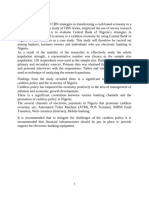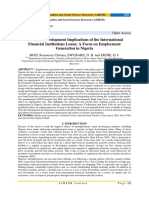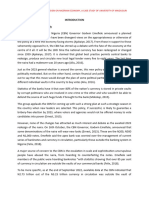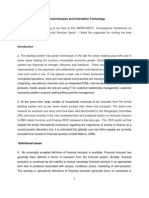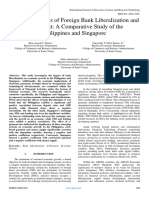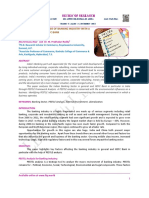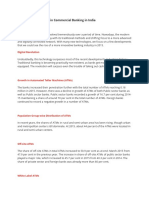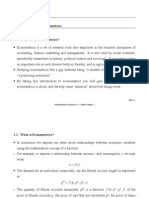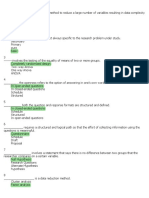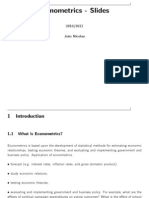694-Article Text-2144-1-10-20240105
694-Article Text-2144-1-10-20240105
Uploaded by
hauwamodibbogireiCopyright:
Available Formats
694-Article Text-2144-1-10-20240105
694-Article Text-2144-1-10-20240105
Uploaded by
hauwamodibbogireiCopyright
Available Formats
Share this document
Did you find this document useful?
Is this content inappropriate?
Copyright:
Available Formats
694-Article Text-2144-1-10-20240105
694-Article Text-2144-1-10-20240105
Uploaded by
hauwamodibbogireiCopyright:
Available Formats
International Journal of Management & Entrepreneurship Research, Volume 6, Issue 1, January 2024
OPEN ACCESS
International Journal of Management & Entrepreneurship Research
P-ISSN: 2664-3588, E-ISSN: 2664-3596
Volume 6, Issue 1, P.No.30-45, January 2024
DOI: 10.51594/ijmer.v6i1.694
Fair East Publishers
Journal Homepage: www.fepbl.com/index.php/ijmer
CASH CRUNCH AND THE NIGERIAN ECONOMY
NMORSI, Japhet1, NKECHUKWU, Gabriel Chukwu2, ASIAGWU, Harriet3
1
Department of Marketing, Delta State University of Science and Technology,
Ozoro, Nigeria
2&3
Department of Banking and Finance, Faculty of Management Sciences,
Chukwuemeka Odumegwu Ojukwu University, Anambra State, Nigeria.
___________________________________________________________________________
Corresponding Author: NMORSI, Japhet
Corresponding Author Email: japhnmorsi@gmail.com / ucheharriet@gmail.com
Article Received: 04-11-23 Accepted: 25-12-23 Published: 05-01-24
Licensing Details: Author retains the right of this article. The article is distributed under the terms of
the Creative Commons Attribution-Non Commercial 4.0 License
(http://www.creativecommons.org/licences/by-nc/4.0/), which permits non-commercial use,
reproduction and distribution of the work without further permission provided the original work is
attributed as specified on the Journal open access page.
___________________________________________________________________________
ABSTRACT
This study examined cash crunch and the Nigerian economy. To achieve this objective, relevant
data used spanning from 1981-2022 were obtained for the review period from the Central Bank
of Nigeria (CBN) Statistical Bulletin and World Bank Indicators. Descriptive statistics,
Augmented Dickey Fuller (ADF) Unit root test, Granger causality and Ordinary Least Square
(OLS) regression were the analytical tools for this study. Real Gross Domestic Product growth
rate (RGDPgr) was used as the dependent variable, while Cash crunch proxy with prime lending
rate (CC), Domestic credit by Banks to private sector (DCBPS), Loan to deposit ratio (LDR),
Inflation Rate (INFR), Money supply growth rate (MSgr) as the independent variables. Based
on the analysis, there exist positive relationship between RGDPgr, CC, DCBS, LDR, and M2gr
and a negative relationship existed RGDPgr and INFR. The F-statistic of the regression output
stood at 6.208930, this implies that the regression plane is statistically significant. It was also,
revealed that cash crunch had negative and significant effect on the Nigerian economy C = -
11.97721, P < 0.05 (0.0265 < 0.05), while the overall Prob.(F-Statistic) 0.000302 is less than
the 0.05 level of significance implies that there is a statistical significant relationship between
the variables. R2= 0.463044 implies that about 46.30% of the total variation in the model
specified was accounted for by the independent variables. LDR is platykurtic, RGDPgr, CC,
Nmorsi, Nkechukwu, & Asiagwu, P.No. 30-45 Page 30
International Journal of Management & Entrepreneurship Research, Volume 6, Issue 1, January 2024
DCBPS, INFR and M2gr are leptokurtic, according to the descriptive analysis, which also
showed that all the variables were normally distributed; All the variables were stationary and
significant at their respective values. There is the existence of a long-run relationship between
the variables indicated by Johansen co-integration equation. Therefore, cash crunch has
negative effect on investment in an economy. In conclusion, cash crunch had negative and
significant impact on the expansion of Nigerian economy for the period studied. The study
recommended that the government through CBN should modified most of its tools and
incorporate some of the macro prudential variables in its dealings so as to have robust grips of
the economy with the intention of suppressing the adverse effect of inflationary pressure in the
economy.
Keywords: Cash Crunch, Domestic Credit By Banks To Private Sector, Inflation, Money
Supply And Nigerian Economy.
___________________________________________________________________________
INTRODUCTION
when an organization does not possess sufficient funds to operate successfully or in the normal
way. Most companies that file for bankruptcy are undergoing some kind of cash crunch.
Nigeria is currently experiencing a cash crisis, which the central bank said was brought on by
efforts to remove excess cash from circulation in order to speed up the country's transition to a
cashless economy. Data from the Central Bank of Nigeria (CBN) show that between October
2022 and February 2023, N2.3 trillion was taken out of circulation as a result of the apex bank's
efforts to redesign high-denomination currency in the largest economy in Africa and lower the
amount of money in circulation.
The crisis cost the economy an estimated N20 trillion, according to a March research by the
Lagos-based Centre for the Promotion of Private Enterprise, one of the many issues with the
currency policy. The Central Bank of Nigeria (CBN) declared on October 26, 2022, that it
would be redesigning the N200, N500, and N1000 notes and substituting the outdated ones with
the updated versions. "Assist in checking counterfeit notes, strengthen the economy, lower cash
management costs, promote financial inclusion, and improve the CBN's visibility of the money
supply" was the stated goal of the program. The majority of the money in circulation—85%,
according to the CBN—is held underground or is utilized for illegal purposes when it’s not
inside banks. Given that inflation has been increasing over the previous few months, they
planned to take stock of the currency outside of banks and reintegrate it into the financial
system. This would allow them to maintain accurate records of the quantity of currency that is
in use.
However, several analysts have noted that the timing of redesigning the currency was a bad one,
especially since Nigeria approached elections in February 2023, and the timeframe was too
short to implement such a nationwide policy without witnessing snags in the procedure. The
CBN had scheduled the usage of the old notes for January 31, 2023, but extended that deadline
due to pressure from banks, lawmakers, and corporate organizations. However, because to the
huge quantities of money that were still in circulation and outside of banks, the deadline was
moved up to February 10, 203. The financial crisis between January and March had a significant
impact on economic activity, nearly bringing an end to everyday operations as a result of the
inability to obtain funds. Money became more in demand. The policy's effects were further
exacerbated by certain people, especially point-of-sale (POS) agents, who went so far as to sell
Nmorsi, Nkechukwu, & Asiagwu, P.No. 30-45 Page 31
International Journal of Management & Entrepreneurship Research, Volume 6, Issue 1, January 2024
the currency for a higher price to be able to benefit themselves. Other banks were also reported
to have stockpiled the updated notes.
The currency redesign program has caused millions of citizens to fall into poverty and destitute
due to its many upheavals and hardships, particularly because it has taken over 70% of the
country's cash supply (Muda, 2023), according to the organization's CEO.
Similar to how pandemic lockdowns in 2020 triggered a rise in the adoption of e-banking, the
scarcity is prompting Nigerians in large numbers to join up for digital and electronic banking
services. This is also resulting in an unmanageable and quick transition away from a system
centered around currency. Politically driven, the financial crisis has been connected to the
government's efforts to curb vote-buying in the general elections.
LITERATURE REVIEW
Conceptual Review
According to data from the Nigerian Interbank Settlement System, mobile banking transactions
reached a record high that month, increasing year over year by more than five times to 183.7
million. In contrast, the 108.1 million transactions recorded for January are mentioned here.
The CBN and all Nigerian regulated deposit money banks own NIBSS.
Within a single year, the value of mobile banking transactions increased from N1.1 trillion to
N2.6 trillion. From late February to October, mobile banking transactions more than doubled.
when the CBN first announced its plan to reform its currency. In February, the quantity of point-
of-sale (POS) terminals installed nationwide reached a record high, coinciding with the volume
and the transactional value completed via POS terminals reaching their peak.
Alternative Payment Options
The economic downturn has additionally spurred activity on the platforms of numerous digital
banks and payment companies that are popping up around the nation, including commercial
bank applications, OPay, and PalmPay. Increased financial inclusion was sparked by Covid,
which ideally would have required Nigerians to go through a learning curve to ensure they were
present on digital payment platforms. The cash crisis will undoubtedly reinforce the necessity
for everyone to sign up for an online account in order to increase financial inclusion in rural
regions. To further enhance the level of financial inclusion biometric-based point-of-sale
systems should be used in remote regions and marketplaces (Babatunde, 2023)
CURRENCY REDESIGN
Currency Re-design and Monetary Policy in Nigeria
Currency permits private and public-sector agents of different countries to interact in
international economic and financial activity by using it as a means of payment, a unit of
account or a store of value.
The achievement of both an internal and external balance of payments has consistently been the
goal of monetary policy over the years. However, over time, the focus on methods and tools to
accomplish those goals has shifted. The pursuit of monetary policy has been divided into two
main periods: before and after 1986. Direct monetary restrictions were given priority in the first
phase, whereas market processes are crucial in the second. Monetary policy in 2021 was created
to mitigate the effects of shocks to the Nigerian economy caused by a number of changes in the
local and international economies (CBN, 2021). This prompted the general consensus in Nigeria
that the financial crisis was caused by flaws in the financial system, which also served to spread
the problem. Still up for contention, though, is the underlying.
Nmorsi, Nkechukwu, & Asiagwu, P.No. 30-45 Page 32
International Journal of Management & Entrepreneurship Research, Volume 6, Issue 1, January 2024
Except for the 50 Kobo bill, all banknotes in circulation in Nigeria were recolored in April 1984
in an effort to counter the rampant money trafficking that was going on at the time. In 1991, the
50K and 1K were both introduced. The CBN began issuing banknotes in the country's currency
on July 1st, 1959, and the Western Area Central Bank (WACCB) ceased producing coins and
banknotes. There was no change to the currency to reflect the nation's republican status until
July 1st, 1962. The top of the banknotes that formerly said "FEDERATION OF NIGERIA" was
now imprinted with "FEDERAL REPUBLIC OF NIGERIA." In 1968, new notes were issued
as a reaction to the misappropriation of the cash during the American Civil War.
The Nigerian currency was renamed in January 1973 following the government's decision to
convert from metric to decimal. As the fundamental money unit, the naira (10 shillings) replaced
the £1. A hundred kobo was worth one naira, making it a small unit. A fresh 20 naira (20)
coinage was introduced on February 11th, 1977. At the time, the demand for ease, the
inclination toward cash transactions, and the expansion of the economy made it the highest
denomination ever adopted.
The late Head of State, General Murtala Ramat Muhammad (1938–1976), who spearheaded the
July 1975 Nigerian Revolution, is featured on the money, the first of its kind in the nation. On
the first anniversary of his assassination, the note was distributed as a fitting remembrance of a
very outstanding son of Nigeria. He was acclaimed as a national hero on October 1, 1978 (CBN,
2015).
New currency banknotes in the denominations of 1, 5, and 10 were launched on July 2, 1979.
These notes were the same dimensions, measuring 151 by 78 mm, as the 20 note that was
released on February 11th, 1977. The different denominations were given unique colors to make
identification easier. The notes featured three prominent Nigerians who were proclaimed
national heroes on October 1st, 1978. The notes' back engravings depicted many facets of the
nation's culture (The Guardian, 2022).
With the exception of the 50 Kobo banknote, all banknotes in circulation underwent a color
change in April 1984 in an effort to counteract the then-rife currency trafficking. The 50K and
1K were both established in 1991. In response to the economy's growth and to help an effective
payments system, the 100, 200, 500, and 1000 banknotes were launched in December 1999,
November 2000, April 2001, and October 2005, respectively (CBN, 2015).
As part of the economic reforms, which also included the reissue of the 50, 10, and 5 banknotes,
the introduction of the 2 coin, and the redesign of the 1 and 50K coins, the 20 was first published
on polymer substrate on February 28, 2007. Because the 20 (polymer) banknotes performed
well, the revised 50, 10, and 5 banknotes were switched to a polymer substrate on September
30, 2009. Consequently, all lesser denomination banknotes were now printed on the polymer
substrate.
The CBN created two commemorative bank notes to mark Nigeria's 100 years of existence and
50 years of independence: the N100 Commemorative banknote was printed on December 19,
2014, and the 50 Commemorative polymer bank note was printed on September 29, 2010.
Only a trillion of the alleged three trillion Naira notes in circulation have been reported by the
banks, according to CBN Governor Godwin Emiefiele. It follows that the remaining few billion
are assumed to be hoarded somewhere.
Nmorsi, Nkechukwu, & Asiagwu, P.No. 30-45 Page 33
International Journal of Management & Entrepreneurship Research, Volume 6, Issue 1, January 2024
Redesigning the N200, N500, and N1000 will assist solve some of Nigeria's security issues,
namely money laundering, abduction, and terrorism, aside from the politicians that piled up the
bigger nominations. Sources claim that the goal of the program is to seize the enormous quantity
of cash that is not in the banking system, which is now estimated to be 2.73 trillion, or almost
85% of all cash in circulation. As a result, this action clears the economy of a significant amount
of "black money," strengthens security, and makes it possible for authorities to keep an eye on
the nation's financial flow (CBN, 2022).
Additionally, by bringing the majority of people into the financial system, the monetary policy,
and currency design will contribute to deeper financial inclusion. According to these sources,
It is necessary to restrict the quantity of money in use, advance improved cashless policies, raise
the system's credit limit, and potentially fight inflation. Only four of the 54 African nations print
their currencies domestically, including Nigeria, but this may not be obvious to many Nigerians.
Because of this, most African nations print their money elsewhere and import it in the same
manner as other goods (Vanguard, 2022).
THEORETICAL REVIEW
Modern Theory of Interest Rate or Hicks IS-LM Curve: Hicks IS-LM model is believed
that both goods market forces and money market forces determine rate of interest and real
income. Known as the determinate theory of interest rates, it also illustrates how the money and
commodity markets interact. This theory has some elements in its consideration such as savings,
investment, liquidity preference and availability of funds in determining rate of interest and real
income in both commodity market and money market with the help of IS-LM curves. The IS
curve was created by combining savings and investments made in the commodities market,
whereas the LM curve was created by combining the accessibility of funds and the inclination
towards liquidity. While the LM curve displays the interest rate that balances the money market
at any income level, the IS curve illustrates the interaction that leads to equilibrium between the
interest rate and the level of income in the goods market. Furthermore, the IS curve represents
the equilibrium interest rate and income level combinations in the goods and services market,
whereas the LM curve represents the equilibrium interest rate and income level combinations
in the real money balance market. Thus, in the short run, when the price level is fixed, the
interest rate and the national income are simultaneously defined by the is-lm curves.
Interest rate effects of monetary policy adjustments at a certain income level demonstrates how
the availability of real money balances affects the equilibrium interest rate. When the monetary
authority raises the money supply at a particular level of real money balances and the rate of
interest falls, for example, the money market reaches equilibrium at a low rate of interest. The
LM curve shifts downward as a result. Also when the supply of money decreases; the rate of
interest increases which leads to increase in the rate of interest that shifts the LM curve upward
and the money market will achieved equilibrium at high rate of interest. As a consequence, the
LM curve demonstrates the positive correlation between income and interest rate.
Business cycle theory: under this theory, the economy is often battered by unexpected shocks.
Unexpected changes in monetary or fiscal policy are a common source of shocks to aggregate
demand. Shocks to aggregate supply are usually defined as shifts in productivity, which can be
brought about by temporary adjustments to raw material costs, production structure, or
technology. In an ideal world, when the economy experiences positive shocks, businesses
Nmorsi, Nkechukwu, & Asiagwu, P.No. 30-45 Page 34
International Journal of Management & Entrepreneurship Research, Volume 6, Issue 1, January 2024
would grow, decide to produce more, and pay employees more; when it experiences negative
shocks, they would do the opposite (Alan, 2010).
Theories of Money Demand
In 1936, Keynes introduced the ideas of demand for money, stating that people save money for
transactions, emergencies, and speculation. Thus, in keeping with the research of Bates et al.
(2009), this study embraces the inventory-theoretic (transactional motive) and precautionary
motive. Bates et al, (2009) emphasized that transactional and precautionary motives are the two
major factors that previous researchers have identified as determinants of a firm's cash holding.
Inventory-Theoretic Approach
This theory states that inventory (money) is held for transaction purposes. It was developed by
Baumol in 1952 and Tobin in 1956. In their individual researches, the authors demonstrated a
functional link between interest and money. In their own research, they came to the conclusion
that a sensible wage earner will always prefer to "withdraw an amount of money that minimizes
both opportunity and transaction costs". The opportunity cost of losing interest and income that
would have been earned on the money had it been invested, then, is what drives the demand for
money. Money demand is impliedly a function of interest rates and income (money demand =
f(income and interest rate)).
Because income and expenses are predictable, agents are expected to hold cash for daily
transactions under the cash advance strategy created by Clower (1967). This technique referred
to as transactional motive. It describes a person's or SMEs' wish to have adequate cash on hand
for transactions. The hypothesis referred to as the transaction motive maintains that there's no
requirement for people or businesses to pay extra money to turn fixed assets into cash (Honda
& Uesugi, 2021).
Precautionary Approach
Precautionary demands are a fallout from the perception that individuals are uncertain about the
payments they might want, have, and or to make (Whalen, 1966). It is the desire to hold
sufficient cash for unforeseen contingencies. For the purpose of preserving a well functioning
business, SMEs must maintain sizeable cash reserves for unforeseen financial needs (Almeida
et al, 2004; Riddick & Whited, 2009; Duchin, et al, 2010; Honda & Uesugi, 2021).
Empirical Literature
The adoption of cashless transactions policy, which encourages the use of electronic or plastic
money for transactions, has a notable effect on the sales of small and medium firms. Customers
prefer to utilize cash rather than electronic or plastic money, according to prior empirical
research (Kaseke, 2012; Hafalir & Loewenstein, 2009; Kaur & Kaur, 2008; Patil, 2014;
Sakarombe & Marabada, 2017). This implies that consumers would put off purchases if they
don't have cash, which will possess an impact on sales and profitability.
Within Nigeria, the application of electronic or ATM cards had led to arguments and fights and
resulted in police cases between the vendor and buyers. For example, traders using POS, there'll
be a deduction to the customer's account, the POS machine teller will indicate a decline and the
seller account not be credited. In light of this transaction, the client will be deprived to collect
items from which the account had been debited for that purpose. Painfully, the bank may not
reverse the erroneously deducted amount until 2 to 3 weeks based on the bank. Finding out how
Zimbabwean consumers felt about using cash versus electronic or plastic money (ATM cards)
in the post-multi-currency period was the purpose of Kaseke's (2012) study. Credit cards, debit
Nmorsi, Nkechukwu, & Asiagwu, P.No. 30-45 Page 35
International Journal of Management & Entrepreneurship Research, Volume 6, Issue 1, January 2024
cards, and master or visa cards are used as stand-ins for plastic money in this qualitative survey
study. The findings indicate that gender and educational attainment positively impact the
payment with plastic cards. It was noted, although, that there were several difficulties with its
adoption related to network failure and security. Credit card expenditure was studied by Hafalir
and Loewenstein (2009). The findings show that credit cards benefit convenience consumers
while negatively affecting revolvers. As a consequence, the study categorized revolver users as
either customers who have access to credit facilities or as customers who do not.
The Indian government created the 500 and 1,000 Indian rupee denominations in 2016.
According to reports, the then-prime minister Narendra Mordi wanted to cut the amount of
money in use over a six-month period and put an end to corruption. The policy's primary goals
were ironically not met, as the sum of money in use rose from 18 trillion rupees in 2016 to 20
trillion rupees in 2018 (Bloomberg, 2018 report).
Furthermore, the Bloomberg report ascertained that “agriculture and small businesses with a
liquidity shock, put people through unnecessary hardship, disrupted supply chains, and
destroyed demand for everything from autos to property”. Furthermore, the International
Monetary Fund (IMF), 2018 asserted that the currency design policy in India led to cash
shortages which directly affect the policy’s performance. Thus, it affected business operations
throughout the nation.
As per Kaur and Kaur (2008), Indians possess an inclination toward carrying cash when doing
transactions. According to their research, 90% of Indians make their purchases with cash rather
than credit or debit cards. Additionally, Patil (2014) conducted a study in India that was
comparable and found that the respondents in the sample preferred using plastic money.
Consequently, this might be associated with development and consciousness, given that the
mere six-year gap existed between the two investigations. Sakarombe and Marabada (2017)
discovered that respondents to their study, which was carried out in Zimbabwe, preferred cash
to electronic money. In light of the survey's findings, 66% of respondents preferred cash, while
only 3% preferred plastic money.
Andreas (2001) looked into how bank lending in Germany responded to changes in monetary
policy. Based on a data set that includes individual balance sheet information for every German
bank, dynamic panel estimations provide empirical evidence that, on average, banks curtail
lending more harshly in reaction to restrictive monetary policy measures. Only depending on
bank size and volume can this be undone.
Along the same lines, De Young, Gron, and Winton (2005) and Kim and Sohn (2017) tow the
same part by investigating on commercial banks in the US economy. The pro-cyclic nature of
bank lending is supported by the loan supply, according to the authors' findings. While bank
lending tends to decrease further in the midst of a downturn than would be implied by a
reduction in bank capital alone, demand for loans was higher and business profitability was
strong during an economic expansion, leading to more profitable loans where banks compete
for business by lending more money at cheaper interest rates. In contrast, Girardi et al. (2018)
found that credit squeezes are less severe during times of consistent economic growth,
particularly when funds are reasonably abundant but monetary policy is restrictive. This finding
was made in their analysis of the Italian industrial sectors. The caliber of bank balance sheets
is to blame for this.
Nmorsi, Nkechukwu, & Asiagwu, P.No. 30-45 Page 36
International Journal of Management & Entrepreneurship Research, Volume 6, Issue 1, January 2024
Borio and Gambacorta (2017) investigate how monetary policy affects bank lending in a low-
interest rate setting. Their empirical research demonstrates that when short-term interest rates
fall to extremely low levels decreasing them have less of an effect on increasing bank lending.
Additionally, the study discovers that the low rates in the evolution of lending during the years
2010–2014 can be employed to explain the profitability of banks. While Charles et al. (2019)
used more evidence in their study, micro-data on loan applications, volumes, and rates, as well
as Uganda's supervisory credit register.
In a recent study, the studies by Tomak (2013), Malede (2014), and Bhattarai (2016) indicated
that bank lending in Turkey, Ethiopia, and Nepal depends more on bank size, investment
portfolio, liquidity ratio, cash reserve requirement, inflation rate, deposit, the gross domestic
product and credit risk in developing economies. Studies show that a monetary contraction
reduces the amount of bank credit accessible by tightening lending volumes and rates,
increasing the number of loan applications that are rejected, and increasing the exposure of
banks to sovereign debt. The aforementioned claims were validated and supported by Udell
(2009), Rottmann & Wollmershauser (2013), and Olweny & Chiluwe (2012), while Ayub &
Seyed (2016)'s findings are in conflict.
Ajayi and Atanda (2012) investigated the effect of monetary policy tools on bank performance
in Nigeria using time series data spanning the years 1980 to 2008. The connection between
monetary policy and bank lending, banking rates, and national commercial banks' profitability
has been examined in other empirical research. While Jegede (2014) and Yunusa, Williams,
and Adegbenle (2020) found in a separate study that there is a long-run relationship between
the variables in the model and the interest rate significantly influenced commercial bank loan
and advances with a target of curbing inflation in the economy, the study concluded that
monetary policy instruments are not effective stimulants for bank lending in NigeriaAfolabi et
al. (2018), Agbonkhese & Asekome (2013), Tsenkwo & Longdu'ut (2013), Ogolo & Magnus
(2018), and others worked on this aspect with varying conclusions and solutions.
Additionally, Matousek and Solomon's (2018) study demonstrates that bank capitalization, size,
and liquidity were important factors in determining the availability of loans during this time. In
contrast, Udoh, Dauda, Ajayi, and Ikpechukwu (2021) contended that the high rates concerning
monetary policy, exchange rate crises, and Nigeria's mounting debt, among other factors, meant
that the tool of monetary policy had no discernible impact on bank lending to the private sector.
The reviews pertaining to this study indicate that there is a mixed relationship between the cash
shortage and the Nigerian economy, notwithstanding the paucity of literature on the subject.
The study's findings will provide more up-to-date, solid, and trustworthy information about how
the cash crunch has affected the expansion of the Nigerian economy. Additionally, this study
will focus more on how the cash constraint affects the tools used by monetary policy makers to
ease bank lending operations to the private sector and the results that result from them.
METHODOLOGY
Research Design
In this study, an ex-post-facto research design was employed. The study's primary emphasis is
Nigeria, and its data ranges across a forty-two year (42) period, from the years 1981 to 2022.
This study made use of secondary data for the period under consideration from the World Bank
Data Base and the Central Bank of Nigeria (CBN) Statistical Bulletin. Cash crunch proxy with
prime lending rate (CC), Domestic credit by Banks to private sector (DCBPS), Loan to deposit
Nmorsi, Nkechukwu, & Asiagwu, P.No. 30-45 Page 37
International Journal of Management & Entrepreneurship Research, Volume 6, Issue 1, January 2024
ratio (LDR), Inflation Rate (INFR), Money supply growth rate (MSgr) as the independent
variables, Real Gross Domestic Product growth rate (RGDPgr) was used as the dependent
variable.
Method of Analysis:
Descriptive statistics, Augmented Dickey Fuller (ADF) unit root test, Granger causality,
Johansen co-integration test and the OLS method were used to test hypotheses from E-Views
9.0.
Model Specification:
The model for this study rested on Hicks and Learner modern theory of interest rate which states
that savings, investment, liquidity preference and money supply determine the rate of interest
in conventional market through IS-LM theory. This study modifies the determinants of the
theory to observe the effect of cash crunch on the Nigerian economy.
The functional relationship between cash crunch and Nigeria economy is expressed as:
RGDPgr = ƒ(CC, DCBPS, LDR, INFR, MS growth rate)…………………Model 1
RGDPgr = ß0+ ß1CC+ ß2DCBPS + ß3LDR + ß4INFR + ß5MSgr + U...Equation 1
Where:
RGDPgr = Real Gross Domestic Product growth rate
CC= Cash crunch proxy with Prime lending rate
DCBPS = Domestic credit by Banks to private sector
LDR = Loan to deposit ratio
INFR = Inflation Rate
MSgr = Money supply growth rate
U = Stochastic disturbance term or error term
ß0 denotes the constant term, ß1 – ß5 are slope of the coefficients representing Parameters to be
estimated and U is the disturbance term assumed to be purely random.
On apriori, it is expected that the dependent variable should have a positive relationship with
the independent variables.
DATA PRESENTATION AND ANALYSIS
Data Presentation:
Table 1
Extracted Efficiency Parameters for Cash Crunch and the Nigerian Economy
PERIOD GDP Cash Domestic Loan to Inflation Money
growth crunch Credit by deposit Rate Supply
rate proxy with Banks to ratio (INFR) Growth rate
(GDPgr) Prime private (LDR) (M2gr)
lending sector (%
rate (CC) of GDP)
(DCBPS)
1981 -13.1 7.75 5.7 71.0 20.8 10.08*
1982 -6.8 10.25 6.4 75.3 7.7 8.89*
1983 -10.9 10.00 6.2 73.7 23.2 13.24*
1984 -1.1 12.50 6.2 72.1 17.8 11.62*
1985 5.9 9.25 6.0 67.7 7.4 12.44
Nmorsi, Nkechukwu, & Asiagwu, P.No. 30-45 Page 38
International Journal of Management & Entrepreneurship Research, Volume 6, Issue 1, January 2024
1986 0.1 10.50 7.5 76.5 5.7 4.23
1987 3.2 17.50 6.6 71.0 11.3 2.92
1988 7.3 16.50 6.0 70.8 54.5 34.99
1989 1.9 26.80 5.0 87.5 50.5 3.54
1990 11.8 25.50 4.9 60.2 7.4 45.92
1991 0.4 20.01 5.0 53.7 13.0 27.43
1992 4.6 29.80 8.2 60.4 44.6 47.53
1993 -2.0 18.32 6.9 68.8 57.2 53.76
1994 -1.8 21.00 8.0 69.6 57.0 34.50
1995 -0.1 20.18 6.5 92.3 72.8 19.41
1996 4.2 19.74 6.2 99.6 29.3 16.2
1997 2.9 13.54 7.0 99.7 8.5 16.1
1998 2.6 18.29 7.6 97.6 10.0 22.3
1999 0.6 21.32 8.2 81.3 6.6 33.1
2000 5.0 17.98 8.2 69.8 6.9 48.1
2001 5.9 18.29 9.8 75.4 18.9 26.4
2002 15.3 24.81 8.1 76.9 12.9 18.8
2003 7.3 20.74 8.9 78.2 14.0 13.5
2004 9.3 19.18 8.5 80.3 15.0 20.7
2005 6.4 17.95 8.4 88.8 17.9 22.6
2006 6.1 17.26 8.1 79.4 8.2 36.4
2007 6.6 16.94 13.4 74.3 5.4 87.8
2008 6.8 15.14 18.6 84.1 11.6 42.2
2009 8.0 18.99 19.6 90.9 12.5 14.9
2010 8.0 17.59 13.5 80.2 13.7 6.7
2011 5.3 16.02 11.0 63.2 10.8 21.7
2012 4.2 16.79 10.6 54.8 12.2 27.1
2013 6.7 16.72 11.5 54.7 8.5 14.3
2014 6.3 16.55 13.3 63.9 8.0 -0.8
2015 2.7 16.85 13.1 73.2 9.0 4.1
2016 -1.6 16.87 14.6 77.9 15.7 31.9
2017 0.8 17.56 12.8 79.8 16.5 1.4
2018 1.9 19.33 10.2 66.3 12.1 15.0
2019 2.2 15.53 10.4 59.1 11.4 6.2
2020 -1.8 12.3 11.2 71.3* 13.2 31.00
2021 3.6 11.5 12.2 70.9* 17 15.8
2022 3.3 13.9 12.9 69.5* 18.8 13.9*
Source: Central Bank of Nigeria (CBN) Statistical Bulletin, World Bank Data Base and *Extrapolation (5 years
average) for the Period under Review (1981-2022).
Interpretation of Result
The descriptive statistics for the time series data for the dependent and independent variables
are displayed in Table 4.2. This serves to illustrate how drastically the variables differ from one
another.
Table 2
Descriptive Statistics Result
RGDPgr CC DCBPS LDR INFR M2gr
Mean 3.047619 17.22714 9.357143 74.56429 18.94048 22.33095
Median 3.450000 17.38000 8.200000 73.45000 12.95000 17.50000
Maximum 15.30000 29.80000 19.60000 99.70000 72.80000 87.80000
Minimum -13.10000 7.750000 4.900000 53.70000 5.400000 -0.800000
Std. Dev. 5.311526 4.612156 3.508814 11.50900 16.45783 17.34707
Skewness -0.830589 0.308313 1.026419 0.359105 1.875680 1.462641
Kurtosis 4.736058 3.533844 3.728433 2.855199 5.430208 6.062869
Jarque-Bera 10.10347 1.164131 8.303334 0.939388 34.96256 31.39228
Probability 0.006398 0.558743 0.015738 0.625194 0.000000 0.000000
Nmorsi, Nkechukwu, & Asiagwu, P.No. 30-45 Page 39
International Journal of Management & Entrepreneurship Research, Volume 6, Issue 1, January 2024
Sum 128.0000 723.5400 393.0000 3131.700 795.5000 937.9000
Sum Sq. Dev. 1156.705 872.1515 504.7829 5430.736 11105.26 12337.75
Observations 42 42 42 42 42 42
The table above displays the descriptive statistics for the variables that were taken into account
throughout our analysis. The average Real Gross Domestic Product growth rate (RGDPgr),
Cash crunch (CC), Domestic credit by Banks to private sector (DCBPS), Loan to deposit ratio
(LDR), Inflation Rate (INFR), and Money supply growth rate (M2gr), between 1981 and 2022
are 3.047619, 17.22714, 9.357143, 74.56429, 18.94048 and 22.33095, respectively. RGDPgr
is negatively skewed as it possessed a skewness value of -0.830589 showing a longer tail to the
left; CC and LDR are normally skewed since they possessed a skewness of 0.308313
and 0.359105 which add up to zero, DCBPS, INFR and M2gr are positively skewed since they
possessed a skewness of value of 1.026419, 1.875680 and 1.462641, showing a longer tail to
the right. LDR is platykurtic since its distribution is flat peaked and had kurtosis of 2.855199
which is lower than 3. RGDPgr, CC, DCBPS, INFR and M2gr are leptokurtic indicating that
their distributions are highly peaked relative to normal, as the kurtosis figure of 4.736058,
3.533844, 3.728433, 5.430208 and 6.062869 are greater than 3. The Jarque-Bera statistic (JB)
for CC an LDR provide enough evidence to accept the null hypotheses of normality since their
p-values of the JB statistic of 0.558743, and 0.625194 are greater than 0.05. Although the p-
values of the Jarque-Bera statistic (JB) for RGDPgr, DCBPS, INFR, and M2gr, respectively,
are less than 0.05, there is sufficient evidence to reject the null hypotheses of normality.
Table 3
Summary of ADF Unit Root Test
Variables ADF Test Mackinnon P-Value Oder of Remark
Statistics Critical Value integration
@ 5%
RGDPgr -3.203603 -2.936942 0.0271 1(0) STATIONARY
CC -3.496668 -2.935001 0.0131 1(0) STATIONARY
DCBPS -5.976132 -2.941145 0.0000 1(1) STATIONARY
DLR -3.533334 -2.936942 0.0120 1(0) STATIONARY
INFR -3.049396 -2.935001 0.0386 1(0) STATIONARY
M2gr -4.276942 -2.935001 0.0016 1(0) STATIONARY
The variables are stationary at order level 1(0) for RGDPgr, CC, DLR, INFR, and M2gr, while
it is stationary at first difference 1(1) for DCBPS.
Table 4
Result of Johansen Co-Integration Test
Date: 11/13/23 Time: 02:24
Sample (adjusted): 1983 2022
Included observations: 40 after adjustments
Trend assumption: Linear deterministic trend
Series: RGDPgr CC DCBPS LDR INFR M2gr
Lags interval (in first differences): 1 to 1
Unrestricted Cointegration Rank Test (Trace)
Hypothesized Trace 0.05
Nmorsi, Nkechukwu, & Asiagwu, P.No. 30-45 Page 40
International Journal of Management & Entrepreneurship Research, Volume 6, Issue 1, January 2024
No. of CE(s) Eigenvalue Statistic Critical Value Prob.**
None * 0.714134 128.1400 95.75366 0.0001
At most 1 * 0.559641 78.05081 69.81889 0.0095
At most 2 0.365951 45.24419 47.85613 0.0862
At most 3 0.276987 27.01903 29.79707 0.1012
At most 4 0.245728 14.04590 15.49471 0.0817
At most 5 0.066809 2.765825 3.841466 0.0963
Trace test indicates 2 cointegrating eqn(s) at the 0.05 level
* denotes rejection of the hypothesis at the 0.05 level
**MacKinnon-Haug-Michelis (1999) p-values
Unrestricted Cointegration Rank Test (Maximum Eigenvalue)
Hypothesized Max-Eigen 0.05
No. of CE(s) Eigenvalue Statistic Critical Value Prob.**
None * 0.714134 50.08923 40.07757 0.0027
At most 1 0.559641 32.80662 33.87687 0.0667
At most 2 0.365951 18.22516 27.58434 0.4765
At most 3 0.276987 12.97314 21.13162 0.4547
At most 4 0.245728 11.28007 14.26460 0.1407
At most 5 0.066809 2.765825 3.841466 0.0963
Max-eigenvalue test indicates 1 cointegrating eqn(s) at the 0.05 level
* denotes rejection of the hypothesis at the 0.05 level
**MacKinnon-Haug-Michelis (1999) p-values
The outcome of the Johansen co-integration test presented above indicates two co-integration
equation from Trace test and one co-integration equation from Max-eigenvalue test. The result
therefore, confirm the existence of co-integration among the variables. Consequently, we can
then draw the conclusion that a long-run relationship between cash crunch and Nigerian
economy. Thus, our null hypotheses were rejected and alternative accepted.
Table 5
Granger Causality Test
Pairwise Granger Causality Tests
Date: 11/13/23 Time: 02:29
Sample: 1981 2022
Lags: 2
Null Hypothesis: Obs F-Statistic Prob.
CC does not Granger Cause RGDPgr 40 1.63676 0.2092
RGDPgr does not Granger Cause CC 4.02700 0.0267
DCBPS does not Granger Cause RGDPGR 40 0.04539 0.9557
RGDPgr does not Granger Cause DCBPS 0.95167 0.3959
LDR does not Granger Cause RGDPgr 40 0.87651 0.4252
RGDPgr does not Granger Cause LDR 1.03323 0.3665
INFR does not Granger Cause RGDPgr 40 0.12121 0.8862
RGDPgr does not Granger Cause INFR 0.22268 0.8015
M2gr does not Granger Cause RGDPgr 40 2.83611 0.0722
RGDPgr does not Granger Cause M2gr 1.44614 0.2492
Nmorsi, Nkechukwu, & Asiagwu, P.No. 30-45 Page 41
International Journal of Management & Entrepreneurship Research, Volume 6, Issue 1, January 2024
There is unidirectional causality when CC does not granger cause RGDPgr (0.2092 > 0.05) and
RGDPgr granger cause CC (0.0267 < 0.05); there is no causality when DCBPS does not granger
cause RGDPgr (0.9557 > 0.05) and RGDPgr does not granger cause DCBPS (0.3959 > 0.05);
There is no causal relationship because LDR does not granger cause RGDPgr (0.4252 > 0.05)
and RGDPgr does not granger cause LDR (0.3665 > 0.05); There is no causal relationship
between INFR and RGDPgr because (0.8862 > 0.05) and (0.8015 > 0.05), respectively;
similarly, M2gr does not cause RGDPgr (0.0722 > 0.05) and RGDPgr does not cause M2gr
(0.2492 > 0.05), hence there is no causal relationship between RGDPgr and INFR.
Table 6
OLS
Dependent Variable: RGDPgr
Method: Least Squares
Date: 11/13/23 Time: 02:32
Sample: 1981 2022
Included observations: 42
Variable Coefficient Std. Error t-Statistic Prob.
C -11.97721 5.174977 -2.314448 0.0265
CC 0.730515 0.154303 4.734274 0.0000
DCBPS 0.302138 0.196144 1.540386 0.1322
LDR 0.020798 0.057661 0.360698 0.7204
INFR -0.119791 0.044499 -2.691965 0.0107
M2gr 0.014827 0.039558 0.374826 0.7100
R-squared 0.463044 Mean dependent var 3.047619
Adjusted R-squared 0.388467 S.D. dependent var 5.311526
S.E. of regression 4.153643 Akaike info criterion 5.817412
Sum squared resid 621.0991 Schwarz criterion 6.065651
Log likelihood -116.1657 Hannan-Quinn criter. 5.908402
F-statistic 6.208930 Durbin-Watson stat 1.349388
Prob(F-statistic) 0.000302
RGDPgr = ß0+ ß1CC+ ß2DCBPS + ß3LDR + ß4INFR + ß5MSgr + U
Thus, using the absolute values of all the variables, the estimated parameters of the regression
model is:
RGDPgr = -11.97721 + 0.730515CC + 0.302138DCBPS + 0.020798LDR - 0.119791INFR +
0.014827M2gr + U
Based on the regression coefficient, the estimated model shows that there exist positive
relationship between RGDPgr, CC, DCBS, LDR, and M2gr; hence, the estimated outcome
showed that a unit change in CC, DCBS, LDR, and M2gr will boost Nigerian economy by value
of 0.730515%, 0.302138%, 0.020798% and 0.014827% respectively. While INFR has negative
relationship with RGDPgr indicating that a unit change in INFR will lead to a decrease in
economic growth by 0.119791I%. The coefficient of determination (R2) is R2 = 0.463044 which
is 46.3044%. This implies that about 46.30% of the total variation were accounted for by the
independent variables while 57.70% was unexplained and has been taken care of by the
stochastic disturbance term or error term U during the period studied. The Durbin-Watson
statistic shows that there is presence of autocorrelation or serial correlation in the residual as its
value of 1.349388, approximately 1.35 which is less than the Durbin-Watson value of 2 (1.35
Nmorsi, Nkechukwu, & Asiagwu, P.No. 30-45 Page 42
International Journal of Management & Entrepreneurship Research, Volume 6, Issue 1, January 2024
< 2). The F-statistic of the regression output stood at 6.208930. This implies that the regression
plane is statistically significant. Comparing Sign P-values with the chosen level of significance
(0.05), it is observed that P-value 0.0000, and 0.0107 for CC, and INFR are less than the chosen
level of significance (0.05), the P-values 0.1322, 0.7204, and 0.7100 for DCBPS, LDR, and
M2gr respectively are greater than 0.05 chosen level of significance. But for the overall level
of significance, Prob.(F-Statistic) 0.000302 is less than the 0.05 level of significance; indicating
that all the independent variables can jointly influence the dependent variable for the period
under review; hence, our null hypothesis which states that cash crunch has no significant effect
on the growth of Nigerian economy is rejected and alternative accepted.
Discussion of Findings
This study on "Cash crunch and the Nigerian economy" revealed that cash crunch had negative
and significant effect on the Nigerian economy C = -11.97721, P < 0.05 (0.0265 < 0.05), while
the overall Prob.(F-Statistic) 0.000302 which is less than 0.05 chosen level of significant
indicated that Cash crunch have a significant relationship with the Nigerian economy for the
period under review.
The results of this study confirmed those of other studies in related fields, such as Matousek
and Solomon (2018) in his study reveals that bank size, liquidity, and capitalization were
significant determinants of loan supply during this period, but contrarily Udoh, Dauda, Ajayi
and Ikpechukwu (2021) opined that monetary policy tool has no strident effect on bank lending
to private sector due to some factors such asː high rates of monetary policy, exchange rate crisis,
Nigeria growing debt among others. Also, the Bloomberg 2018 report ascertained that
“agriculture and small businesses with a liquidity shock, put people through unnecessary
hardship, disrupted supply chains, and destroyed demand for everything from autos to
property”; According to a 2018 International Monetary Fund (IMF) report, India's currency
design strategy caused cash shortages, which had an immediate impact on the policy's
effectiveness. It consequently had an impact on national corporate activities.
SUMMARY OF FINDINGS, CONCLUSION AND RECOMMENDATION
Summary of Findings
According to the descriptive analysis, which also showed that all the variables were normally
distributed; At each of their individual values, every variable was significant and steady. There
is a historical correlation between the cash constraint and the Nigerian economy. The study
found that during the analyzed time, the cash crisis had a negative and considerable impact on
the Nigerian economy.
Conclusion:
Based on our findings, the study concluded that cash crunch had a negative and significant
effect on the growth of Nigerian economy for the period studied.
Recommendation
The study recommended that CBN should modified most of its tools and incorporate some of
the macro prudential variables in its dealings so as to have robust grips of the economy with the
intention of suppressing the adverse effect of inflationary pressure in the economy.
References
Afolabi M A., Adeyemi K., Salawudeen O. S., & Fagbemi, T. O (2018). Monetary Policy and
Bank Credit in Nigeria: A Toda-Yamamoto Approach. Economica Acta Universitatis
Danubius, 14(5).
Nmorsi, Nkechukwu, & Asiagwu, P.No. 30-45 Page 43
International Journal of Management & Entrepreneurship Research, Volume 6, Issue 1, January 2024
Agbonkhese, A., & Asekome, O. (2013). The impact of monetary policy on bank credit creation
in Nigeria. International Journal of Business and Social Science, 4(15), 160-165.
Ajayi, F., & Atanda, A. (2012). Monetary policy and bank performance in Nigeria: A two-step
cointegration approach. African Journal of Scientific Research, 9(1), 34-47.
Ayub, G. & Seyed, A. (2016). The relationship between monetary policy and bank lending
behaviour and the influence of bank specific features on this relationship in the
bankslisted on the Tehran Stock Exchange. International Journal of Advanced
Biotechnology and Research (IJBR), 7(2).
Babatunde, O. (2023). Financial inclusion catalysed by Covid. FinTech Association of Nigeria,
Premium Times, April 15.
Bates, T. W., Kahle, K. M., & Stulz, R. M. (2009). Why do US firms hold so much cash than
they used to? The Journal of Finance, 64(5), 1985-2021.
Baumol, W.J. (1952). The transactions demand for cash: An inventory theoretic approach.
Oxford Journals. https://doi.org/10.2307/1882104
Borio, C., & Gambacorta, L. (2017). Monetary policy and bank lending in a low interest rate
environment: Diminishing effectiveness? BIS Working Papers, 6(12), 1-21.
Central Bank of Nigeria (2015). History of Nigerian Currency.
https://www.cbn.gov.ng/Currency/historycur.asp
Central Bank of Nigeria (2021). The conduct of monetary policy.
https://www.cbn.gov.ng/MonetaryPolicy/Conduct.asp
Central Bank of Nigeria (2022). Redesigning of the Currency. www.cbn.gov.ng
Central Bank of Nigeria (2023). CBN Money and Credit Statistics. Available at
https://www.cbn.gov.ng/rates/mnycredit.asp
Central Bank of Nigeria (2023). CBN Statistical Bulletin. Available at
https://www.cbn.gov.ng/documents/Statbulletin.asp
Clower, R. (1967). A reconsideration of the micro-foundations of monetary theory. Economic
Inquiry, 6(1), 1-8.
De Young, R., Gron, A., & Wiñton, A. (2005) Risk overhang and loan portfolio decisions,
Federal Reserve Bank of Chicago, Working Papers, 1-34.
Duchin, R., Ozbas, O., & Sensoy, B. A. (2010). Costly external finance, corporate
investment,and the subprime mortgage credit crisis. Journal of Financial Economics,
97(3), 418–435.
Girardi A., Margani, P., &Marco, V. (2018). An indicator of credit crunch. Italian Business
Surveys. https://mpra.ub.uni-muenchen.de/88839/MPRA Paper No. 88839.
Hafalir, E., & Loewenstein, G. (2009). The impact of credit cards on spending: A field
experiment. SSRN eLibrary, 1-29.
Honda, T., & Uesugi, I. (2021). Covid-19 and precautionary corporate cash holdings: Evidence
from Japan. Discussion Paper Series, 1-34. The Research Center for Economic and
Social Risks. Institute of Economic Research Hitotsubashi University.
Kaseke, N. (2012). Cash or plastic money-An investigation into the payment mode post
multicurrencyperiod in Zimbabwe. International Journal of Advanced Research in
Management and Social Sciences, 1(6), 102-119.
Nmorsi, Nkechukwu, & Asiagwu, P.No. 30-45 Page 44
International Journal of Management & Entrepreneurship Research, Volume 6, Issue 1, January 2024
Kaur, M., & Kaur, K. (2008). Deveof plastic cards market: Past, present and future scenario in
Indian banks. Asia-Pacific Journal of Management Research and Innovation, 4(4), 62-
74.
Keynes, J. M. (1936). The general theory of employment interest and money. The collected
writings of John Maynard Keynes. Journal of the Czech Geological Society, 49(V11),
161-172.
Matousek, R., & Solomon, H. (2018). Bank lending channel and monetary policy in Nigeria.
Research in International Business and Finance, 45, 467–474.
Muda, Y. (2023). Nigeria’s cash crisis driving digital transactions to all-time high. Premium
Times, April 15.
National Bureau of Statistics (2023). Nigeria Gross Domestic Product Q1 2023. Available at
https://nigerianstat.gov.ng/elibrary
Ogolo & Tamunotonye, M. (2018) monetary policy and commercial bank lending to the
real sector in Nigeria: a time series study. American Finance and Banking Review.
2(1), 10-41.
Patil, S. (2014). Impact of plastic money on banking trends in India. International Journal of
Management Research and Business Strategy, 1-7.
Riddick, L. A., & Whited, T. M. (2009). The corporate propensity to save. The Journal of
Finance, 64(4), 1729–1766.
Riddick, L. A., & Whited, T. M. (2009). The corporate propensity to save. The Journal of
Finance, 64(4), 1729–1766.
Rottman H., & Wollmershauser, T. (2013), A micro data approach to the identification of credit
crunches, Applied Economics, 47, 2423-2441.
Sakarombe, U., & Marabada, N. D. (2017). Electronic money or cash? In face of liquidity crisis
in Zimbabwe. International Journal of Academic Research in Business and Social
Sciences, 7(11), 63-73.
The Guardian (2022). The History of currency introduction and redesign in Nigeria.
https://guardian.ng/opinion/the-history-of-currency-introduction-and-redesign-innigeria/
Tobin, J. (1958). Liquidity preference as behavior towards risk. The Review of Economic
Studies, 25(2), 65-72.
Tsenkwo, B.J., & Longdu’ut, D.T. (2013). The relationship between monetary policy rate and
banking rates: Evidence from regression and multivariate causality analysis. An
International Journal of Arts and Humanities, 2(3).
Whalem, E. L (1966). A rationalization of the precautionary demand for cash. The Quarterly
Journal of Economics, 80(2), 314.
Nmorsi, Nkechukwu, & Asiagwu, P.No. 30-45 Page 45
You might also like
- Business Analytics Data Analysis and Decision Making 7th Edition PDFDocument29 pagesBusiness Analytics Data Analysis and Decision Making 7th Edition PDFjitew65351No ratings yet
- Advanced Econometrics PDFDocument58 pagesAdvanced Econometrics PDFJose CobianNo ratings yet
- ToxstatDocument9 pagesToxstatBárbara Assis CantarelaNo ratings yet
- 814-Article Text-2273-1-10-20240217 2Document11 pages814-Article Text-2273-1-10-20240217 2michaelmatuta36No ratings yet
- 2.Ijbgm-A Cointegration Analysis of The Relationship Between Money Supply and Financial Inclusion in Nigeria - 1981-2016 - RewrittenDocument14 pages2.Ijbgm-A Cointegration Analysis of The Relationship Between Money Supply and Financial Inclusion in Nigeria - 1981-2016 - Rewritteniaset123No ratings yet
- The Impact of Financial InclusionDocument9 pagesThe Impact of Financial InclusionBhuwanNo ratings yet
- The Impact of Financial Innovation On Economic Growth in NigeriaDocument14 pagesThe Impact of Financial Innovation On Economic Growth in NigeriazenommiracleNo ratings yet
- Cashless Policy and Financial Performance of Deposit Money Banks in NigeriaDocument12 pagesCashless Policy and Financial Performance of Deposit Money Banks in NigeriaEditor IJTSRDNo ratings yet
- Banking Innovation, Financial Inclusion and Economic Growth in NigeriaDocument30 pagesBanking Innovation, Financial Inclusion and Economic Growth in NigeriaJohn RizviNo ratings yet
- Evaluation of The Impact of Central Bank of Nigeria's (CBN) Monetary Policy and Its Instruments On The EconomyDocument12 pagesEvaluation of The Impact of Central Bank of Nigeria's (CBN) Monetary Policy and Its Instruments On The EconomyResearch ParkNo ratings yet
- Journal 5Document8 pagesJournal 5tesoriosachiNo ratings yet
- Journal of Interdisciplinary Research in Accounting and FinanceDocument15 pagesJournal of Interdisciplinary Research in Accounting and Financewissem benaliNo ratings yet
- Impact of Digital Finance On Bank's Credit Allocation in NigeriaDocument12 pagesImpact of Digital Finance On Bank's Credit Allocation in NigeriaGbengaNo ratings yet
- Effect of Electronic Banking Innovations On Economic Growth in NigeriaDocument18 pagesEffect of Electronic Banking Innovations On Economic Growth in NigeriaMiftahu IdrisNo ratings yet
- Cashless Policy (2011)Document8 pagesCashless Policy (2011)Nwigwe Promise ChukwuebukaNo ratings yet
- Evaluation of Cashless PolicyDocument59 pagesEvaluation of Cashless Policyse570836No ratings yet
- Impact of Financial Inclusion On Performance of Bank in NigeriaDocument14 pagesImpact of Financial Inclusion On Performance of Bank in NigeriaMiguel DiraneNo ratings yet
- Economic Development Implications of The International Financial Institutions Loans: A Focus On Employment Generation in NigeriaDocument8 pagesEconomic Development Implications of The International Financial Institutions Loans: A Focus On Employment Generation in NigeriaAJHSSR JournalNo ratings yet
- Financial Development and Economic Growth Nexus in Nigeria: Imoagwu, Chika Priscilla, Dr. C.I. EzeanyejiDocument14 pagesFinancial Development and Economic Growth Nexus in Nigeria: Imoagwu, Chika Priscilla, Dr. C.I. EzeanyejiDr. Ezeanyeji ClementNo ratings yet
- An Appraisal of Cashless Economy Policy in Development of Nigerian EconomyDocument17 pagesAn Appraisal of Cashless Economy Policy in Development of Nigerian EconomyAnonymous aXFUF6No ratings yet
- 2) Assessment of The Business LandscapeDocument5 pages2) Assessment of The Business Landscapeishanshezad09No ratings yet
- An Empirical Analysis of The Impact of Agency Banking On FinancialDocument12 pagesAn Empirical Analysis of The Impact of Agency Banking On Financialfarazphd88No ratings yet
- EconsProj NairaRedesignDocument8 pagesEconsProj NairaRedesignabsalomabnerNo ratings yet
- 971-Article Text-2447-1-10-20240326Document28 pages971-Article Text-2447-1-10-20240326ARUNNo ratings yet
- Micro Financing and Economic Development: A Sectorial Microcredit Study From NigeriaDocument17 pagesMicro Financing and Economic Development: A Sectorial Microcredit Study From Nigeriasanthi pushadapuNo ratings yet
- 4Document5 pages4AdemystephenNo ratings yet
- 985-Article Text-2890-3243-10-20191009Document21 pages985-Article Text-2890-3243-10-20191009ZinebNo ratings yet
- 11475-Article Text-32922-1-10-20181129Document29 pages11475-Article Text-32922-1-10-20181129Natinael AbebeNo ratings yet
- The Effect of Financial Institutions On Economic Growth in NigeriaDocument10 pagesThe Effect of Financial Institutions On Economic Growth in NigeriaNwigwe Promise ChukwuebukaNo ratings yet
- Dammy Project ProposalDocument11 pagesDammy Project ProposalEmeka MichealNo ratings yet
- Ameerah Compl PRJDocument67 pagesAmeerah Compl PRJsadiqmedical160No ratings yet
- Financial Inclusion and Information TechnologyDocument8 pagesFinancial Inclusion and Information TechnologydhawanmayurNo ratings yet
- Aishat Project Chapter 1-5Document78 pagesAishat Project Chapter 1-5Emeka MichealNo ratings yet
- Vol 3 No 3 December 2022 Full-100-117Document18 pagesVol 3 No 3 December 2022 Full-100-117Okechukwu LovedayNo ratings yet
- ProposalDocument9 pagesProposaladeyinka DosumuNo ratings yet
- Grassroot MFB RatingDocument13 pagesGrassroot MFB Rating9415351296No ratings yet
- Alternative Banking Channels and Economic Growth in Nigeria: Further Empirical EvidenceDocument6 pagesAlternative Banking Channels and Economic Growth in Nigeria: Further Empirical EvidenceAnonymous traMmHJtVNo ratings yet
- Impact of Debt Sustanability On Nigerian Economic DevelopmentDocument18 pagesImpact of Debt Sustanability On Nigerian Economic DevelopmentCentral Asian StudiesNo ratings yet
- Naira Redesign and Effect To Nigeria Economic DevelopmentDocument48 pagesNaira Redesign and Effect To Nigeria Economic DevelopmentRasaq Eneji Jimoh100% (1)
- Peter Tomilayo HannahDocument45 pagesPeter Tomilayo HannahAkanfeNo ratings yet
- Paper 5 Money TendeDocument14 pagesPaper 5 Money Tendesundayjust830No ratings yet
- The Impact of Private Sector Credit On Economic Growtth in NigeriaDocument22 pagesThe Impact of Private Sector Credit On Economic Growtth in NigeriaMbongeni ShongweNo ratings yet
- Digital Banking Regulations A Comparative Review BDocument25 pagesDigital Banking Regulations A Comparative Review BadivwadhwaNo ratings yet
- Determinants of Voluntary Information Disclosure of Listed Deposit Money Banks in NigeriaDocument17 pagesDeterminants of Voluntary Information Disclosure of Listed Deposit Money Banks in NigeriaSUSAN PETER TERUNo ratings yet
- Economic Effects of Foreign Bank Liberalization and E-Payment: A Comparative Study of The Philippines and SingaporeDocument15 pagesEconomic Effects of Foreign Bank Liberalization and E-Payment: A Comparative Study of The Philippines and SingaporeInternational Journal of Innovative Science and Research TechnologyNo ratings yet
- Relationship Between Credit Risk Management and Financial Performance: Empirical Evidence From Microfinance Banks in KenyaDocument28 pagesRelationship Between Credit Risk Management and Financial Performance: Empirical Evidence From Microfinance Banks in KenyaCatherine AteNo ratings yet
- Effect of Non Interest Income On Profitability On Deposite Money Banks in NigeriaDocument8 pagesEffect of Non Interest Income On Profitability On Deposite Money Banks in NigeriaTriefanyNo ratings yet
- 2019 BC ReportDocument6 pages2019 BC Reportojoma amehNo ratings yet
- Demonetization Scenario in IndiaDocument8 pagesDemonetization Scenario in IndiaNiharika YadavNo ratings yet
- Why Nigeria's Controversial Naira Redesign Policy Hasn't Met Its ObjectivesDocument11 pagesWhy Nigeria's Controversial Naira Redesign Policy Hasn't Met Its Objectiveschizoba okoloNo ratings yet
- MASTERPIECEDocument8 pagesMASTERPIECEAbdulazeez Prince AbdullahiNo ratings yet
- Naira Swap, Electioneering and Insecurity Menace in NigeriaDocument6 pagesNaira Swap, Electioneering and Insecurity Menace in NigeriaOlusegun Alaba Adebayo100% (1)
- Financial Development and SavingsDocument14 pagesFinancial Development and Savingskahal29No ratings yet
- Bank CreditsDocument11 pagesBank CreditsAlexander Decker100% (1)
- Review of Research: A Study On Pestle Analysis of Banking Industry With A Special Reference To HDFC BankDocument6 pagesReview of Research: A Study On Pestle Analysis of Banking Industry With A Special Reference To HDFC BankSAMIR GAMITNo ratings yet
- Implications of Digital Economy For Financial Institutions in Ghana An Exploratory InquiryDocument12 pagesImplications of Digital Economy For Financial Institutions in Ghana An Exploratory Inquiryshandri mayastariNo ratings yet
- The Role of Bangko Sentral NG PilipinasDocument7 pagesThe Role of Bangko Sentral NG PilipinasEden Lour IINo ratings yet
- Banking Sector in IndiaDocument10 pagesBanking Sector in IndiaHarshit KokraNo ratings yet
- Course Title: Financial Management Course Code: Bus 320: AssignmentDocument6 pagesCourse Title: Financial Management Course Code: Bus 320: AssignmentAdemystephenNo ratings yet
- NRB News Vol.36 20770404 PDFDocument6 pagesNRB News Vol.36 20770404 PDFNarenBistaNo ratings yet
- Deborah OladotunDocument50 pagesDeborah OladotunAkanfeNo ratings yet
- Lecture 1.5 Recent Development in BankingDocument6 pagesLecture 1.5 Recent Development in BankingCharu Saxena16No ratings yet
- 2023 CFA L2 Book 1 Quants Eco MultipleDocument63 pages2023 CFA L2 Book 1 Quants Eco MultiplePRNo ratings yet
- The Next 5 Questions Are Based On The Following Information.Document10 pagesThe Next 5 Questions Are Based On The Following Information.testttNo ratings yet
- Applying Digital Analysis Using Benford's Law To Detect Fraud-The Dangers of Type I ErrorsDocument7 pagesApplying Digital Analysis Using Benford's Law To Detect Fraud-The Dangers of Type I Errorskutukupret0% (1)
- ch10 cHuXDocument52 pagesch10 cHuXNaeem UllahNo ratings yet
- EC203 Final Exam (5th May 2023)Document10 pagesEC203 Final Exam (5th May 2023)R and R wweNo ratings yet
- Chapter 1Document18 pagesChapter 1Joseph KandalaftNo ratings yet
- Modelo Estrutural 1Document558 pagesModelo Estrutural 1escolafreiisaiasNo ratings yet
- Assignment 2 4590Document3 pagesAssignment 2 4590aanchaldhar999No ratings yet
- Module 5 - ForecastingDocument13 pagesModule 5 - ForecastingAshima AggarwalNo ratings yet
- AnovaDocument18 pagesAnovaDiya KarNo ratings yet
- Philosophy and The Practice of Bayesian Statistics in The Social SciencesDocument14 pagesPhilosophy and The Practice of Bayesian Statistics in The Social SciencesAnonymous 6duRJjXKNo ratings yet
- HW 4Document2 pagesHW 4PankajNo ratings yet
- 106Document4 pages106vadla snehaNo ratings yet
- Worksheets To Conduct Analysis of Variance Tests: Essentials of Biostatistics in Public Health Lisa M. SullivanDocument3 pagesWorksheets To Conduct Analysis of Variance Tests: Essentials of Biostatistics in Public Health Lisa M. SullivanEko YulyantoNo ratings yet
- Summary On One Sample Hypothesis TestingDocument1 pageSummary On One Sample Hypothesis TestingFaizah ZulkifliNo ratings yet
- Data TransfermationDocument16 pagesData TransfermationBhuvanaNo ratings yet
- Chapter1Questions and SolutionsDocument3 pagesChapter1Questions and SolutionsMohammed NajibNo ratings yet
- Lampiran. 4. Hasil Uji Asumsi Klasik 1. Uji Normalitas: One-Sample Kolmogorov-Smirnov TestDocument2 pagesLampiran. 4. Hasil Uji Asumsi Klasik 1. Uji Normalitas: One-Sample Kolmogorov-Smirnov TestKhalid EurekaNo ratings yet
- MakaleDocument18 pagesMakalemerthizmaliNo ratings yet
- Naveen Kumar - Inferential StatisticsDocument14 pagesNaveen Kumar - Inferential Statisticspchnaveen1988No ratings yet
- BUS105e Formula SheetDocument8 pagesBUS105e Formula SheetmelodyNo ratings yet
- 1 205Document205 pages1 205bicameloNo ratings yet
- Matched Pair+Hypothesis+TestingDocument8 pagesMatched Pair+Hypothesis+TestingAmarnathMaitiNo ratings yet
- Lec16 - Testing of TDocument15 pagesLec16 - Testing of TSaad Nadeem 090No ratings yet
- ECMT1020 Formulas 2021Document9 pagesECMT1020 Formulas 2021Darius ZhuNo ratings yet
- Latihan 1 Ibu YunitaDocument17 pagesLatihan 1 Ibu Yunitapoli bedahNo ratings yet
- Stat. AssignmentDocument3 pagesStat. Assignmentpepz funnelNo ratings yet















